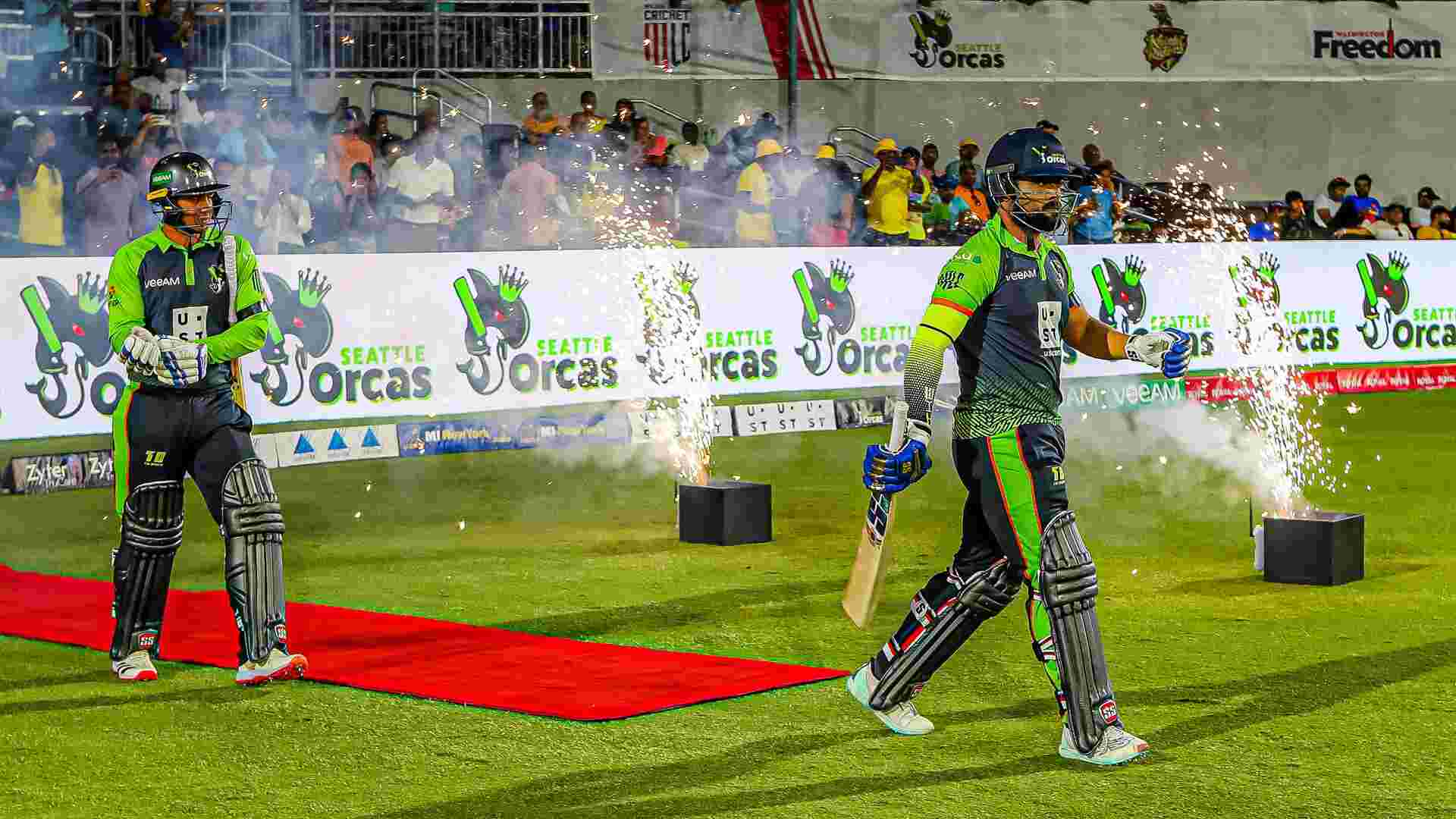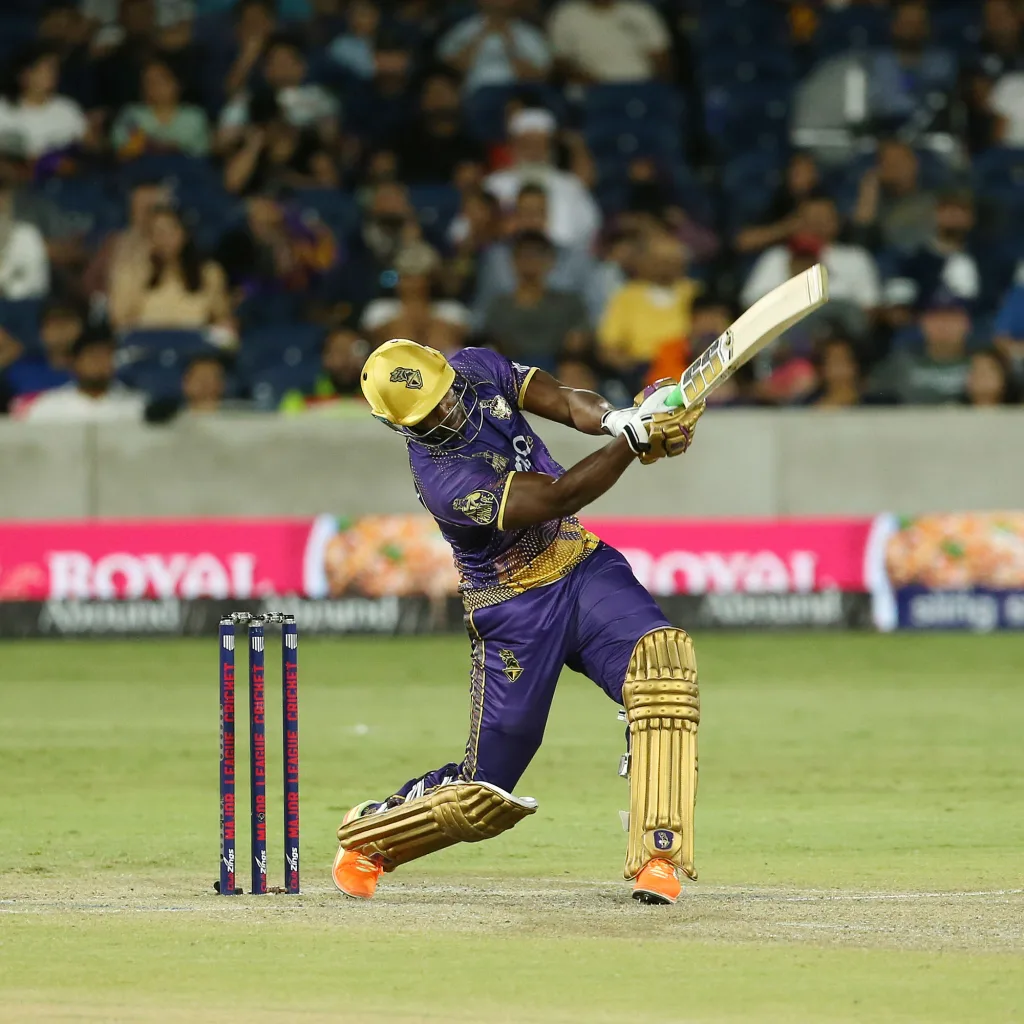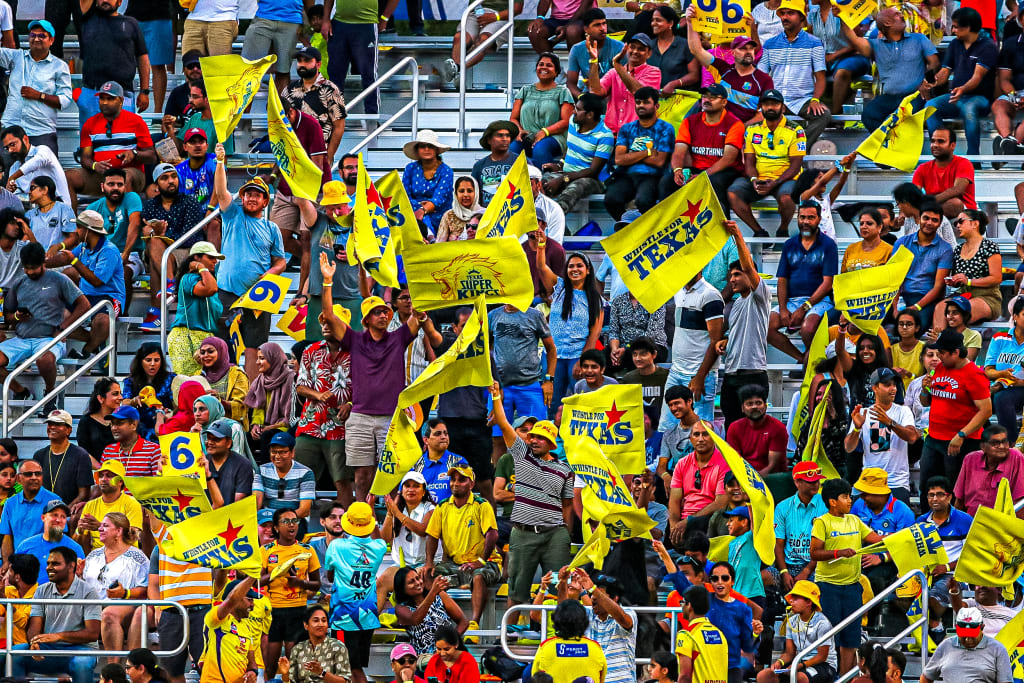- | 8:00 am
Why Satya Nadella and other tech titans are betting on cricket to become a new American pastime
The founders and investors in Major League Cricket are tapping into the sport’s diaspora to create a new world order for T20 cricket.

Cricket may be the second most-watched sport in the world, but witnessing it being played in front of 14,000 fans on Long Island is nonetheless peculiar. The United States is not a cricketing nation, to put it mildly. Cricket didn’t even register on a recent Gallup poll of Americans’ favorite sports to watch, lagging behind bowling, wrestling, and rodeo.
But on a Saturday in early June, batsmen and bowlers from the Netherlands and South Africa faced off in a group stage match of the T20 Men’s Cricket World Cup, co-hosted by the U.S. for the first time, along with the West Indies.
If you didn’t look closely, you’d be excused for thinking you had stumbled onto a baseball game. Vendors sold overpriced tall boys of Miller Lite; food trucks served up cheeseburgers and chicken tenders; and mascots (in this case, Blaze and Tonk) greeted fans. The game itself was a dynamic, quickfire contest, with South Africa eking out a win. Between plays, Doja Cat and Usher boomed from the speakers.
But it was a more global affair than most baseball games. Not only did fans of the competing countries gather at the makeshift stadium that had been assembled for the tournament, wearing the bright orange and lime green of their national teams, but so did cricket fans from all different backgrounds. “Now cricket’s finally come to New York, we’ve got to be here!” said fan Bhushan Amrit, who lives in Queens and is of Guyanese descent.
And still, all this was just something of a preamble to the next day, when the 34,000-capacity stadium would sell out for India versus Pakistan. Cricket fever was alive—on American turf.
Some fans with bigger stakes in the game are hoping cricket mania will last well beyond the tournament, which concludes on Saturday with India facing South Africa in the final in Barbados. Less than a week later, Major League Cricket will begin its second season, with six U.S. professional clubs vying to lift America’s latest sporting trophy.
The league may be young, but it has some heavy-hitting backers, many of them high-profile Indian-American tech leaders. Among its investors and club owners are Microsoft CEO Satya Nadella, Adobe CEO Shantanu Narayen, and venture capitalist and former Amazon tech director Anand Rajaraman (whose aptly-named team is the San Francisco Unicorns). They’re betting they can impress a diaspora fanbase that’s committed to its favorite sport, while also converting some more traditional American sports fans.
The league’s founders and investors believe that the U.S. —a market with enormous room for growth for a sport that barely exists within its borders—is the next logical frontier for cricket. The nation has a long history of fostering successful sports models. “We aren’t looking to reinvent the wheel,” says Major League Cricket cofounder Vijay Srinivasan. “We are trying to be very much in line with how sport is done here in the U.S.”
But with stateside adoption, Srinivasan says he and his co-founders also want to create a “new world order” of cricket, changing the way the sport is played across the globe.
TAPPING INTO THE CRICKET DIASPORA
The roots of Major League Cricket date back to 2002, when Srinivasan cofounded Willow TV International, a channel for U.S.-based cricket fans to watch matches. After growing the channel from streaming to cable, he sold it to the Times of India Group in 2016. Three years later, he and Willow TV cofounder, Sameer Mehta, joined with two Times Group’s executives to found Major League Cricket.
The franchise league is starting small, with just six teams competing in a season that’s more like a tournament, compressed into just three weeks. Only one of the teams, the Dallas-based Texas Prairie Kings, has its own stadium. (The team is co-owned by Anurag Jain and Ross Perot Jr, cofounders of venture capital firm Perot Jain.) The others—in Seattle, San Francisco, Los Angeles, Washington D.C., and New York—expect to have stadiums in the coming years.
TV viewership is also relatively small. The only way to watch Major League Cricket in the U.S. is to subscribe to Willow TV, which currently reaches about four million households nationwide, or the Yankees’ YES Network, which recently committed to co-airing seven matches from the MI New York team.
In other ways, Major League Cricket is starting big. It has raised capital from at least 20 people, and its investors and club owners are some of the most high-profile tech entrepreneurs in the country. It’s also poached some of the biggest names in world cricket as coaches and players. “The U.S. is seen as the world’s largest professional sports market,” Srinivasan says. “To have an opportunity to move the needle in that market is the type of challenge that really invigorates competitive people.”
The majority of the investors themselves are from South Asian descent, and carried with them to America the nostalgia and passion for the sport. “Cricket was very central to their lives,” Srinivasan says. “The opportunity to bring that game into the U.S. was really the reason they signed up.”
Nadella’s co-investor in Major League Cricket’s Seattle Orcas club is Sivaramakichenane Somasegar, who spent almost 30 years at Microsoft before becoming managing director at Madrona Venture Group. He and Nadella are building the Orcas’ stadium with their funds. Once it’s completed, ideally within the next two years, he says that he and Nadella will have invested in the mid-to-high tens of millions of dollars. “We think if we can build a great product,” he says, “people will lap it up, absorb it, [and] take it to a whole new level that we can’t even imagine.”
These entrepreneurs are no strangers to the risks of venture investing. And in launching this new sporting product to America, there are massive unknowns. What they do know is their initial audience: They have a natural spectator base among the 5.4 million households in the U.S. that are South Asian, which is the fastest-growing Asian population in the country.
The league taps into a “large and influential” diaspora community in the U.S., says Simon Chadwick, a professor at SKEMA Business School, in Paris, whose research focuses on sports, economics, and geopolitics. Having a sport financed by Indian-Americans and dominated by many Indian-Americans on the pitch, “may well become a very important aspect of rising Asian ethnic identification and pride,” says Orlando Patterson, a professor of sociology at Harvard who has written on cricket.
Expanding outside the diaspora bubble to find fans who haven’t yet followed cricket is a harder sell. Major League Cricket’s investors are divided on that goal. Srinivasan keeps expectations modest: “Every single new fan we convert is a cherry on top of what we already have,” he says.
But Somasegar would consider it defeat if cricket doesn’t reach the same level of popularity in the U.S. as football or basketball. “We think we would have failed,” he says, “if 10 or 20 years from now, we are still targeted only at the diaspora.”

REVIVING A NORTH AMERICAN PASTIME
If cricket takes off in America, it would be a revival. The sport, after all, was once one of the most popular in the nation. It’s said that George Washington played it with his troops at Valley Forge in 1778. It was played across the East Coast in the 1800s; at one time, Philadelphia had more than 100 cricket clubs. And in 1844, a contest between the U.S. and Canada was the first-ever international cricket match.
But in a nation striving for cultural independence from Britain, many Americans weren’t comfortable with cricket’s prominence. “Its demise was quite deliberate,” Patterson says. Starting in the 1880s, during a particularly nativist era, sporting goods magnate Albert Spalding waged a public campaign against the sport, positioning cricket as elite and effete, a mere pastime in contrast to “the robust, tough, fast, red-blooded” sport of baseball, Patterson says. In 1905, Spalding went so far as to create a commission to deduce the origins of baseball, questionably concluding that it had purely American roots and did not evolve from English cricket. Baseball became America’s game; cricket petered out.
More than a century later, cricket will have to start virtually from scratch again. But the T20 game format, which shortens matches to a few hours and has rejuvenated cricket by shifting it from a “colonially embedded pastime to a global sport,” Chadwick says, could be key to unlocking American attention.
T20 limits teams to 20 overs apiece (one over is six ball deliveries). It encourages risk-taking, and leads to matches that are more frenetic, aggressive, and competitive. It’s the kind of format in which a novice U.S. team could defeat powerhouse Pakistan, as happened this World Cup. It’s also a spectacle: Players wear vibrant uniforms, music thumps out between ball deliveries, and when a batsman is “bowled” out, the wickets (the set of sticks that must collapse behind him) flash with embedded LED lights.
T20 is a far cry from the “old order” of test cricket, which can last a leisurely five days, with conservative play, all-white kits, and intermittent tea breaks. “That kind of cricket did need to change because it had a very limited constituency,” Chadwick says.
Though India didn’t invent the T20 format, it has accelerated its adoption. The Indian Premier League (IPL), which started in 2008, is cricket’s most popular league, and a brand worth an estimated $11 billion. (Two of the Major League Cricket teams, the Texas Super Kings and the L.A. Knight Riders, are owned by IPL franchises with the same names.)
With the help from the IPL, T20 has transformed the sport to one that is now faster than baseball. When cricket appears as an Olympic sport for the first time in 2028—in Los Angeles—it will take the T20 format, surely an incentive for the gold-hungry USA.

A GLOBAL GAME, PLAYED LOCALLY
That all makes cricket more palatable to stateside fans—and investors, who like that cricket also has natural TV ad breaks ready to be filled between overs and outs. “You can compartmentalize cricket in a way that is more suitable for U.S. audiences,” Chadwick says. Though Willow TV has a hold on U.S. cricket coverage, Srinivasan says it is branching out with new partnerships like the one he just inked with the YES Network.
But it will take more than eyeballs on TV for the league to truly thrive. If the goal is to “permeate through the society here,” as the Seattle Orcas’s Somasegar says, cricket needs grassroots infrastructure, and part of the team investors’ funds are going directly to building that ecosystem. Since 2017, American Cricket Enterprises, the organization under which Major League Cricket sits, has quietly set up some three-dozen cricket academies for young people across the country. A range of minor league teams in each of the six cities where Major League Cricket teams exist also now serve as pipelines for the league.
That’s a major and expensive undertaking for a three-week season. In the coming years, the co-founders want to expand the season to ten teams, and between six to eight weeks of play. Srinivasan says this would complement the global cricket calendar, not overtake it. The allotted summer slot follows the end of the IPL, so the revered coaches from the Indian league (and beyond) are free to work in the U.S. The Major League Cricket season does, however, interfere with other cherished traditions, like the centuries-old English County Championship.
By simply slotting its season into that short time frame, American cricket might finish what India has started: transforming the sport from one that’s most popularly played between nations, to one most popularly played between domestic clubs. Srinivasan says he envisions a “new world order” for the game, placing franchise league cricket at the forefront, and building international cricket around that—much like how professional soccer is played. “We are just going along with what the winds of the global cricket ecosystem seem to be trending towards,” he says.
Even a few years ago, Chadwick would not have thought this shift possible, but he says sports have recently transcended borders like never before. There are NFL games in Munich, and soon in Mexico City; the Spanish Super Cup featuring Barcelona and Real Madrid has become a staple in Saudi Arabia; and this summer, the Mets and Phillies played at a Premier League stadium in London. “Baseball at West Ham United—what the hell?” Chadwick exclaims.
“It’s a bit of a chaotic free-for-all,” he adds. “All the old certainties are eroding. Anything’s possible right now.”







































